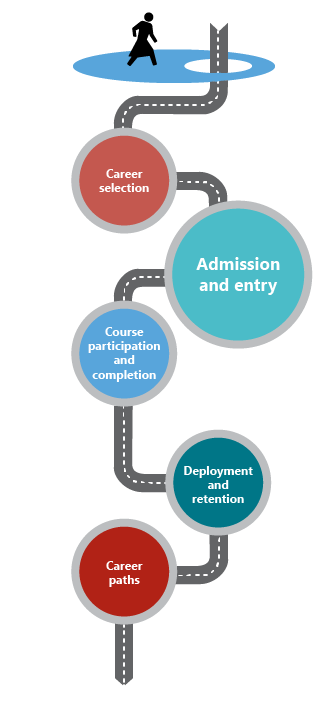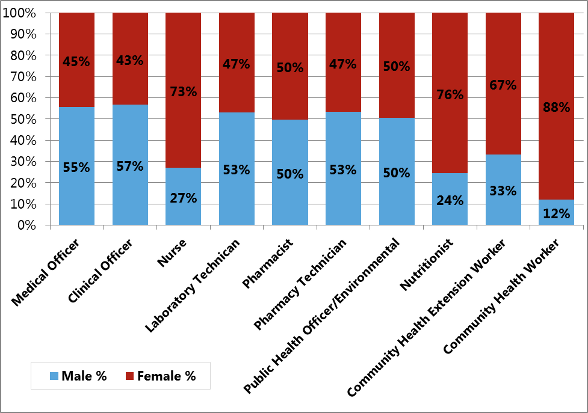 Gender stereotyping and caregiver responsibilities discrimination
Gender stereotyping and caregiver responsibilities discrimination
As health professional students enter courses of study, they may face challenges related to gender stereotyping, pregnancy, or family responsibilities discrimination that discourage them from entering their desired program of study and reaching their full potential as health workers. These obstacles contribute to a reduced number of health workers produced within a given country, which may adversely affect national health outcomes, especially in places where there is a shortage or maldistribution of health workers.
As applications for health professional programs are reviewed, review panels/committees may not favorably view female or male candidates for a program of study due to gender stereotyping. Review panels should be gender-blind, meaning they do not know the gender of the candidate they are evaluating and should promote nondiscrimination on the basis of sex. Universities could make available their admissions statistics to demonstrate student demographic trends.
The pool of potential health professional students may be limited due to gender roles before they even reach the tertiary education level. As was observed in Rwanda, “traditional gender roles such as domestic chores and family care, entrench girls’ underperformance throughout their schooling. This has a cyclical effect, as low performance in the primary exit exam results in girls being admitted to lower-quality secondary schools, and ultimately into higher education institutions in lower numbers” (Huggins and Randell 2007). Admissions committees may not consider female candidates who have gaps in their studies due to pregnancy or caregiving responsibilities.
There may be negative attitudes toward girls and women pursuing training and scholarship opportunities (Standing 2000). For example, prospective female students are often discouraged from initiating activities outside the home. They may instead be expected to care for children and sick or elderly family members. For studies away from home, the availability of secure accommodation for female students may be a concern. Likewise, for male or female students who are expected to earn money for their household, leaving for studies may not be financially viable. In some instances, there are age limits for scholarship opportunities that may adversely affect women. For example, a study conducted in Kenya noted that the cut-off age for scholarships was 42, an age when many women are occupied with caring for their families (Karega 2001).
Suggested data analyses
Sex-disaggregated analyses of the number of students enrolled in or applying to each health professional program of study can help you to better understand if there are gender differences in career selection that could be attributed to gender stereotyping.
In the chart below showing results from a survey of 42 institutions across Kenya, varying proportions of male vs. female students enroll in different health professional training programs. “Masculine” professions such as medicine have higher proportions of male students, whereas “feminine” professions such as nursing and nutrition—as well as programs that require less training and are less well remunerated such as community health work—have higher proportions of female students (Newman et al. 2011).
Enrollment of Health Professional Students by Training Program and Gender at 42 Institutions, Kenya 2010

Source: Newman et al. 2011
Qualitative research, surveys, focus group discussions, or other special studies with health professional students can help you to understand the underlying factors and dynamics contributing to challenges at application, admission, and entry, and whether gender stereotypes or caregiver responsibilities discrimination prevent male and/or female students from successfully entering programs of study.
Ask Yourself:
|


